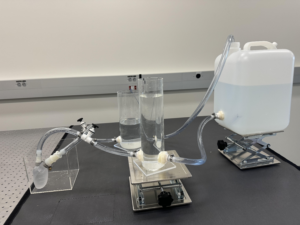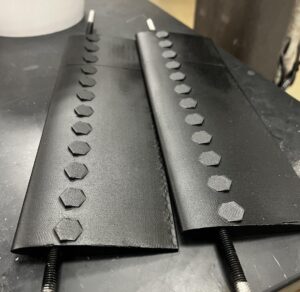Flow quantification in a CDC bioreactor

Bioreactors are often used to observe what factors influence biofilm growth and removal. Biofilms, and formed by pathogenic bacteria adhering to surfaces of food or materials. This can lead to infection on a large scale, with 48 million people getting sick from food-borne diseases of biofilm growth. The biofilm attachment process is heavily dependent on surface roughness of the object. A CDC Bioreactor is used in experimentation as there are eight rods holding three coupons each, meaning there are 24 sampling opportunities varying material and surface roughnesses. Shear stress can be measured on each coupon, which will give a better quantifiable understanding as to how surface roughness influences the biofilm attachment process.
Flow through aortic valves in in-vitro flow loops

Cardiovascular disease (CVD) is one of the most prevalent and fatal conditions worldwide. To simulate cardiovascular dynamics, a lumped parameter modeling approach, based on the Windkessel model, was used to develop a mock circulatory loop (MCL). This loop comprises compliance chambers, resistances, a tank, a model, and a pulsatile syringe pump. Traditional MCL designs typically operate within a closed system, delivering either steady or pulsatile flow to the model. This study addresses that limitation by introducing a soft robotic sleeve actuated by a pulsatile pump, accurately replicating cardiovascular system dynamics. The fluid subsystem uses a mixture of glycerol, water, and urea to closely match the refractive index and blood-mimicking properties of the model. Particle image velocimetry, an optical measurement technique, is employed to analyze the flow field by quantifying velocity distributions.
Low speed aerodynamics with surface modification

Interest in promoting the laminar-to-turbulent flow transition to enhance lift over wings at low Reynolds numbers has grown significantly over time. Typically high Reynlds number flows lead to turbulent boundary layer development over airfoil surfaces. However, surface irregularities can amplify unstable waves in the fluid flow, causing earlier onset of turbulence, delaying separation. Our focus is on improving the aerodynamic performance of stationary or oscillating airfoils at low Reynolds numbers by introducing surface roughness. This promotes a transition to turbulent flow, stabilizing the laminar separation bubble over the airfoil. The increasing demand for Micro Aerial Vehicles (MAVs) in both military and civilian applications has made surface flow control at low Reynolds numbers a critical area of research. We aim to uncover the fundamental physics of laminar-to-turbulent flow transition facilitated by hexagonal roughness elements at low Reynolds numbers.